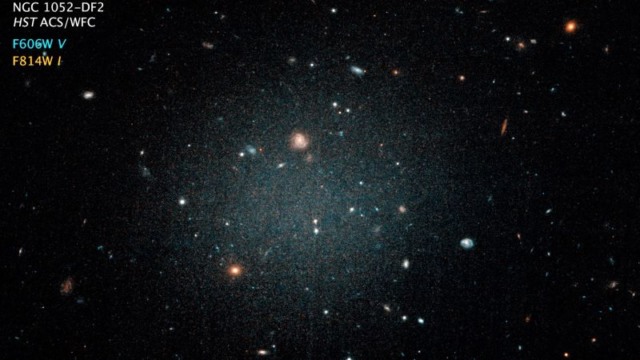Space Swoon: Astronomers Find Galaxy With *Almost* No Dark Matter
This is one of this cosmic stories that pops-up every so often, and I just fucking love. Astronomers have found a galaxy with almost no dark matter. This is, of course, a wet fart on the face of conventional astronomical wisdom. Which I love.
Gizmodo:
From what scientists have gathered, galaxies are nearly synonymous with dark matter. They seem to be mostly dark matter with specks of regular matter mixed in. Despite the fact that no dark matter has been directly observed with science experiments, galaxies’ strange motion is the knock-out reason why astronomers think the universe is filled with six times more of this mysterious stuff than regular matter.
Except now, astronomers for the first time have identified a galaxy that seems to lack any dark matter at all.
This galaxy, called NGC1052-DF2 is entirely new territory as far as observations go. But paradoxically, it might strengthen the case for dark matter’s existence. NGC1052-DF2 shows that these strange, ultra-diffuse galaxies have a whole lot more to teach astronomers.
“These ultra-diffuse galaxies have a huge variety of properties,” study lead author Pieter van Dokkum from Yale University told Gizmodo. “Some have a lot of dark matter, and some have no dark matter. There’s such an enormous range.”
If something has a lot of gravity, then the objects orbiting it need to move quickly around it so they don’t spiral into the center. But nearly every galaxy seems to rotate way faster around its edges than the amount of visible matter they contain would imply. That’s led astronomers to believe that these galaxies are filled with lots and lots of dark matter. Scientists had already cataloged NGC1052-DF2, but when they monitored the motion of 10 of its bright clusters of stars, it didn’t seem to rotate at all, according to the paper published today in Nature.
“We could only derive an upper bound to the measured motion because it’s moving so slowly that our instrument couldn’t detect it,” said van Dokkum.
Van Dokkum has characterized other ultra-diffuse galaxies with the Dragonfly Telephoto Array. His team recently discovered another galaxy, Dragonfly 44, whose physical appearance nearly matches NGC1052-DF2. But that galaxy’s velocity implies that it’s more than 99 percent dark matter.
Not only does this show the diversity of these diffuse objects, but it actually strengthens the case for dark matter. Several physicists have posited that dark matter is actually just a place where our existing theories miscalculate the effects of gravity in the universe’s larger structures. But those theories would fall apart trying to explain the differing behavior of Dragonfly 44 and NGC1052-DF2.




